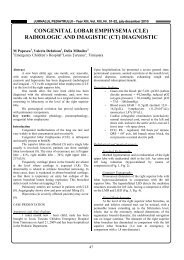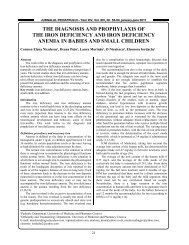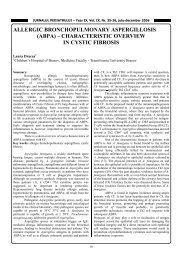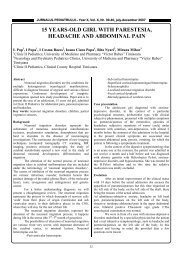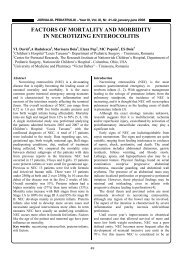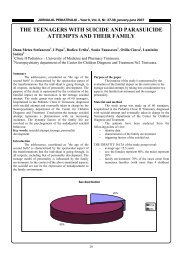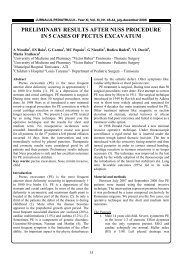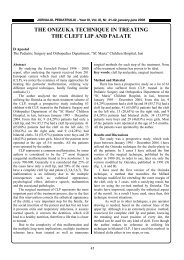address editor in chief co-editors secretary editorial board
address editor in chief co-editors secretary editorial board
address editor in chief co-editors secretary editorial board
Create successful ePaper yourself
Turn your PDF publications into a flip-book with our unique Google optimized e-Paper software.
JURNALUL PEDIATRULUI – Year XV, X<br />
, Vol. XV, Nr. 59-60<br />
60, , july<br />
j<br />
uly-december 2012<br />
URINARY TRACT INFECTION, SIGN OF DIAGNOSIS<br />
OF VESICOURETERAL REFLUX - CASE PRESENTATION<br />
Anca Gabriela Bădescu¹, C Tica¹, Larisia Mihai¹, Mihaela Munteanu², C Chiriac-Babei³, I Bâscă³<br />
Abstract<br />
Ureteral abnormalities represent a <strong>co</strong>mplex and often<br />
<strong>co</strong>nfus<strong>in</strong>g subset of urological anomalies that manifest <strong>in</strong><br />
many ways. However, <strong>in</strong> the current era, hydronephrosis<br />
that is evident on fetal ultrasonography often heralds a<br />
ureteral abnormality. (1)<br />
Ureteral duplication is the most <strong>co</strong>mmon renal<br />
abnormality, occurr<strong>in</strong>g <strong>in</strong> approximately 1% of the<br />
population and 10% of children who are diagnosed with<br />
ur<strong>in</strong>ary tract <strong>in</strong>fections. In<strong>co</strong>mplete ureteral duplication, <strong>in</strong><br />
which one <strong>co</strong>mmon ureter enters the bladder, is rarely<br />
cl<strong>in</strong>ically significant. Alternatively, <strong>co</strong>mplete ureteral<br />
duplication, <strong>in</strong> which 2 ureters ipsilaterally enter the<br />
bladder, has a propensity for vesi<strong>co</strong>ureteral reflux <strong>in</strong>to the<br />
lower pole and obstruction of the upper pole, which can be<br />
problematic.<br />
The authors present a case of a very late diagnosed<br />
malformation reffer<strong>in</strong>g to a ur<strong>in</strong>ary system, with an already<br />
<strong>in</strong>stalled reflux nephropathy. The case is about a ur<strong>in</strong>aryrenal<br />
malformation associated with vesi<strong>co</strong>ureteral reflux,<br />
manifested by ur<strong>in</strong>ary tract <strong>in</strong>fection, first positive episode<br />
diagnosed at high age.<br />
Positive diagnosis was facilitated by laboratory<br />
<strong>in</strong>vestigations (ur<strong>in</strong>e analysis, ur<strong>in</strong>e culture, void<strong>in</strong>g<br />
cystourethrography, static renal sc<strong>in</strong>tigraphy).(1)<br />
Key words: void<strong>in</strong>g cystourethrography, ur<strong>in</strong>ary tract<br />
<strong>in</strong>fection, vesi<strong>co</strong>ureteral reflux, ureter duplication.<br />
Introduction<br />
The pielo-ureteral duplication is a kidney with two<br />
pielo-caliceale systems dra<strong>in</strong><strong>in</strong>g two ureters, enter<strong>in</strong>g the<br />
bladder through two orifices, which are either united or go<br />
through a s<strong>in</strong>gle orifice.(2) Is the most frequent abnormality<br />
of ureters. These children are most <strong>co</strong>mmonly affected by<br />
UTIandpyelonephritis, both <strong>in</strong> vesi<strong>co</strong>-ureteral reflux and<br />
through the obstruction.<br />
The duplicate appears when there is a fast bifurcation<br />
of ureteralbud, result<strong>in</strong>g <strong>in</strong> a bifid ureter or when there are<br />
two ureteralbuds risen from mesonefroticduct, result<strong>in</strong>g <strong>in</strong> a<br />
double ureter. The two resulted renal units are called poles.<br />
Renal surface may reveal a ditch separat<strong>in</strong>g the two poles,<br />
which have <strong>in</strong>dependent vascularity and <strong>in</strong>trarenal<br />
anastomosis. The upper segment is smaller, dra<strong>in</strong>ed by a<br />
s<strong>in</strong>gle caliceal group and the ureter opens wider caudal <strong>in</strong>to<br />
the bladder at the lower pole. The lower pole is bigger,<br />
dra<strong>in</strong>ed by two potassium and by a well developed pelvis.<br />
Often the upper pole gets cut off, and the urography gives<br />
the appearance of "Wilted Flower" due to view<strong>in</strong>g only the<br />
lower pole.(3)<br />
From an embriological po<strong>in</strong>t of view, the appearance<br />
of ureteral duplication with double ureter is subject to the<br />
pr<strong>in</strong>ciple of Weigert-Meyer, a<strong>co</strong>rd<strong>in</strong>d to which the ureteral<br />
buds cranial revealed on the Wolf channel will have a caudal<br />
orifice <strong>in</strong> the future bladder and those emerged caudal, will<br />
have a cranial orifice. This theory expla<strong>in</strong>s the presence of<br />
the cross<strong>in</strong>g that characterizes the route of double ureters so<br />
that <strong>in</strong> the ureteral duplicate, the upper pole of the urete<br />
opens caudal <strong>in</strong> the bladder from the lower pole.<br />
Vesi<strong>co</strong>ureteral reflux occurs most frequently <strong>in</strong> the<br />
lower pole s<strong>in</strong>ce caudal ureter opens sided and cranial <strong>in</strong>to<br />
the bladder and has a shorter submu<strong>co</strong>sal trajectory. (1).<br />
Vesi<strong>co</strong>ureteralreflux occurs on the upper pole when two<br />
orifices are adjacent or when its ureter opens distal to the<br />
cervix and therefore does not have any support to the<br />
detrusor. (4)<br />
The pr<strong>in</strong>ciples of therapeutic <strong>in</strong>dication are the same as<br />
those for primary vesi<strong>co</strong>ureteral reflux, and reimplantation<br />
techniques <strong>address</strong>es to both ureters as they present<br />
<strong>co</strong>mmune vascularity <strong>in</strong> the distal part. Ureteral anastomosis<br />
tech<strong>in</strong>ques and reimplantation of one ureter may be useful <strong>in</strong><br />
some cases (4).<br />
Case presentation<br />
The authors present a case of malformation of ur<strong>in</strong>ary<br />
system late diagnosed, when reflux nephropathy is already<br />
<strong>in</strong>stalled.<br />
In the Pediatric Surgery Cl<strong>in</strong>ic of Constanta County<br />
Emergency Hospital has admitted a female patient, aged 11<br />
years and 9 months, for fever and abdom<strong>in</strong>al pa<strong>in</strong>. There<br />
wasn’t any micturition difficulty, such as pollakiuria or<br />
dysuria. Past medical history sows no ur<strong>in</strong>ary <strong>in</strong>fections.<br />
Dur<strong>in</strong>g the exam<strong>in</strong>ation we f<strong>in</strong>d a child with a weight<br />
weakness stature (size 135 cm, weight 30 kg), but no pale<br />
sk<strong>in</strong>, with dark ur<strong>in</strong>e, without any pathological changes.<br />
Laboratory <strong>in</strong>vestigations revealed a WBC <strong>co</strong>unt of<br />
20000/mm ³, with predom<strong>in</strong>ance of granulocytes, ESR = 26<br />
mm / h, normal blood urea and serum creat<strong>in</strong><strong>in</strong>e, CRP<br />
positive, ur<strong>in</strong>e analysis with frequent leukocyte, positive<br />
nitrite, pH 7, ur<strong>in</strong>e culture showed the presence of E. <strong>co</strong>li.<br />
¹County Emergency Hospital Constanța<br />
²Children Hospital„Sfânta Maria” Iași<br />
³Children Hospital „Grigore Alexandrescu” Bucharest<br />
E-mail: badescuanca2000@yahoo.<strong>co</strong>m, <strong>co</strong>nstant<strong>in</strong>.tica@yahoo.<strong>co</strong>m, larisia_mihai@yahoo.<strong>co</strong>m,<br />
mihaelamunteanu2001@gmail.<strong>co</strong>m, cbcatal<strong>in</strong>@yahoo.<strong>co</strong>m, ion.basca@gmail.<strong>co</strong>m<br />
6



